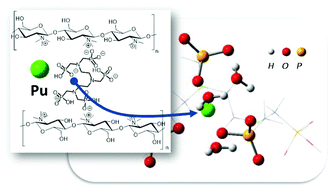当前位置:
X-MOL 学术
›
Dalton Trans.
›
论文详情
Our official English website, www.x-mol.net, welcomes your feedback! (Note: you will need to create a separate account there.)
Towards the development of chitosan nanoparticles for plutonium pulmonary decorporation†
Dalton Transactions ( IF 4 ) Pub Date : 2018-08-03 00:00:00 , DOI: 10.1039/c8dt02419g Laurane Léost 1, 2, 3, 4, 5 , Jérôme Roques 6, 7, 8, 9, 10 , Anne Van Der Meeren 9, 11, 12, 13, 14 , Luc Vincent 1, 2, 3, 4, 5 , Nicolas Sbirrazzuoli 1, 2, 3, 4, 5 , Christoph Hennig 15, 16, 17, 18, 19 , André Rossberg 15, 16, 17, 18, 19 , Jean Aupiais 5, 11, 14, 20, 21 , Sophie Pagnotta 1, 4, 5, 22 , Christophe Den Auwer 1, 2, 3, 4, 5 , Christophe Di Giorgio 1, 2, 3, 4, 5
Dalton Transactions ( IF 4 ) Pub Date : 2018-08-03 00:00:00 , DOI: 10.1039/c8dt02419g Laurane Léost 1, 2, 3, 4, 5 , Jérôme Roques 6, 7, 8, 9, 10 , Anne Van Der Meeren 9, 11, 12, 13, 14 , Luc Vincent 1, 2, 3, 4, 5 , Nicolas Sbirrazzuoli 1, 2, 3, 4, 5 , Christoph Hennig 15, 16, 17, 18, 19 , André Rossberg 15, 16, 17, 18, 19 , Jean Aupiais 5, 11, 14, 20, 21 , Sophie Pagnotta 1, 4, 5, 22 , Christophe Den Auwer 1, 2, 3, 4, 5 , Christophe Di Giorgio 1, 2, 3, 4, 5
Affiliation

|
Since the 1940s, great amounts of Plutonium (Pu) have been produced for both military and civil purposes. Until now, the standard therapy for decorporation following inhalation has been the intravenous injection of diethylenetriaminepentaacetic acid ligand (Ca-DTPA form). This method offers a strong complexing constant for Pu(IV) but has poor chemical specificity, therefore its efficacy is limited to actinides present in the blood. Consequently, there is no decorporation treatment currently available which efficiently removes the intracellular Pu(IV) trapped in the pulmonary macrophages. Our research shows that a nanoparticle approach could be of particular interest due to large contact area and ability to target the retention compartments of the lungs. In this study, we have focused on the inhalation process involving forms of Pu(IV) with poor solubility. We explored the design of biocompatible nanoparticles able to target the macrophages in the lung alveoli and to chelate the forms of Pu(IV) with poor solubility. Nanoparticle formation was achieved through an ionic cross-linking concept using a polycationic polymer and an anionic chelate linker. We chose N-trimethyl chitosan, for its biocompatibility, as the polycationic polymer base of the nanoparticle and the phosphonic analogue of DTPA, diethylenetriamine-pentamethylenephosphonic acid (DTPMP) as the anionic chelating linker in forming NPs TMC-DTPMP. The synthesis and physico-chemical characterization of these NPs are presented. Secondly, the complexation mechanisms of TMC-DTPMP NPs with Thorium (Th(IV)) are discussed in terms of efficiency and structure. The Extended X-Ray Absorption Fine Structure (EXAFS) of the TMC-DTPMP complex with Th(IV) as well as Pu(IV) are defined and completed with DFT calculations to further delineate the plutonium coordination sphere after complexation. Finally, preliminary cytotoxicity tests onto macrophages were assayed.
中文翻译:

面向壳聚糖纳米粒子开发的pulmonary肺降解†
自1940年代以来,已经为军事和民用目的生产了大量的P(Pu)。到目前为止,吸入后分解的标准疗法是静脉注射二亚乙基三胺五乙酸配体(Ca-DTPA形式)。该方法为Pu(IV)提供了很强的络合常数,但化学特异性差,因此其功效仅限于血液中存在的act系元素。因此,目前没有可有效去除细胞内Pu(IV)的解离处理。)被困在肺巨噬细胞中。我们的研究表明,由于大的接触面积和靶向肺保留腔的能力,纳米粒子方法可能会引起特别关注。在这项研究中,我们集中于涉及溶解度较差的Pu(IV)形式的吸入过程。我们探索了生物相容性纳米粒子的设计,该纳米粒子能够靶向肺泡中的巨噬细胞并螯合溶解性较差的Pu(IV)形式。通过使用聚阳离子聚合物和阴离子螯合连接剂的离子交联概念实现了纳米颗粒的形成。我们选择了N-三甲基壳聚糖,由于其生物相容性,作为纳米粒子的聚阳离子聚合物基础和DTPA的膦酸酯类似物,在形成NPs TMC-DTPMP时作为阴离子螯合连接剂的是二亚乙基三胺-五亚甲基膦酸(DTPMP)。介绍了这些NP的合成和理化特性。其次,TMC-DTPMP的NP与钍(Th(络合机制IV))在效率和结构方面进行了讨论。定义了具有Th(IV)和Pu(IV)的TMC-DTPMP配合物的扩展X射线吸收精细结构(EXAFS),并通过DFT计算完成,以进一步描述配合后的coordination配位球。最后,测定了对巨噬细胞的初步细胞毒性测试。
更新日期:2018-08-03
中文翻译:

面向壳聚糖纳米粒子开发的pulmonary肺降解†
自1940年代以来,已经为军事和民用目的生产了大量的P(Pu)。到目前为止,吸入后分解的标准疗法是静脉注射二亚乙基三胺五乙酸配体(Ca-DTPA形式)。该方法为Pu(IV)提供了很强的络合常数,但化学特异性差,因此其功效仅限于血液中存在的act系元素。因此,目前没有可有效去除细胞内Pu(IV)的解离处理。)被困在肺巨噬细胞中。我们的研究表明,由于大的接触面积和靶向肺保留腔的能力,纳米粒子方法可能会引起特别关注。在这项研究中,我们集中于涉及溶解度较差的Pu(IV)形式的吸入过程。我们探索了生物相容性纳米粒子的设计,该纳米粒子能够靶向肺泡中的巨噬细胞并螯合溶解性较差的Pu(IV)形式。通过使用聚阳离子聚合物和阴离子螯合连接剂的离子交联概念实现了纳米颗粒的形成。我们选择了N-三甲基壳聚糖,由于其生物相容性,作为纳米粒子的聚阳离子聚合物基础和DTPA的膦酸酯类似物,在形成NPs TMC-DTPMP时作为阴离子螯合连接剂的是二亚乙基三胺-五亚甲基膦酸(DTPMP)。介绍了这些NP的合成和理化特性。其次,TMC-DTPMP的NP与钍(Th(络合机制IV))在效率和结构方面进行了讨论。定义了具有Th(IV)和Pu(IV)的TMC-DTPMP配合物的扩展X射线吸收精细结构(EXAFS),并通过DFT计算完成,以进一步描述配合后的coordination配位球。最后,测定了对巨噬细胞的初步细胞毒性测试。



























 京公网安备 11010802027423号
京公网安备 11010802027423号